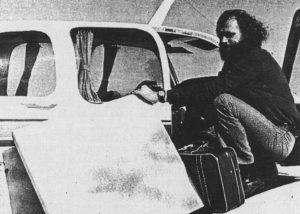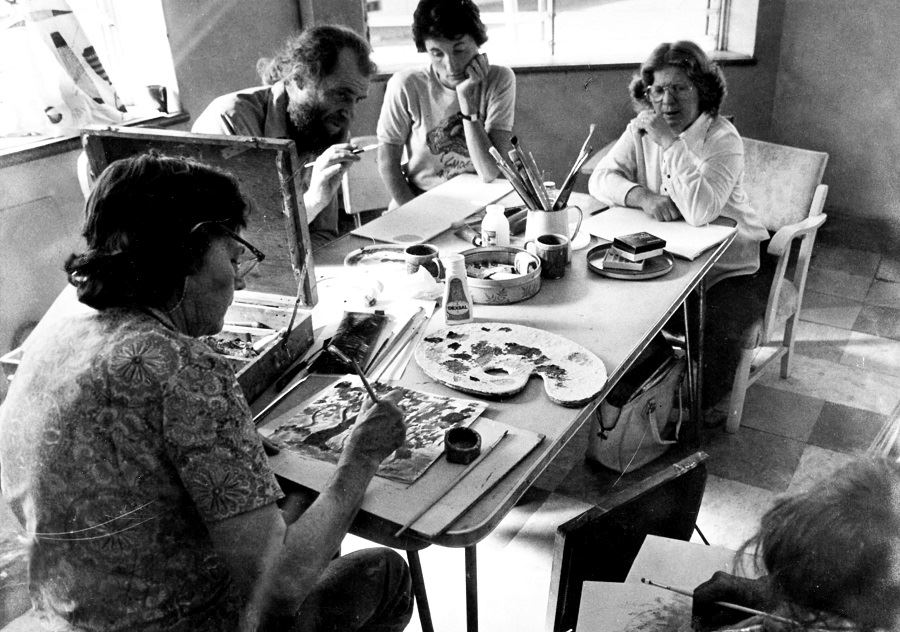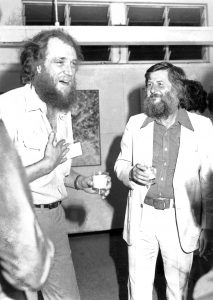
Merv [was] charismatic, philosophical, anti-elitist, and generous. He modestly describes himself as a “student of his students”, and [was] greatly inspired by the people he met and taught, and places his teaching and travels led him.
– Sarah Barron, Curator
COLOUR: Mervyn Moriarty, A Retrospective Exhibition
After a lifetime as one of Australia’s most esteemed art educators and artists, Flying Arts Alliance Founder Mervyn ‘Merv’ Moriarty passed away peacefully on the first of November 2021 in Daylesford, Victoria.
Mervyn’s passing is bittersweet for the Flying Arts community as the news comes only one month since the organisation celebrated its 50th anniversary of his maiden flight – marking the start of his courageous mission to bring visual arts education to the most remote reaches of Queensland and New South Wales.
An artist’s curiosity

Born in 1937 and raised in a creative family, Merv displayed a natural affinity for the arts from a young age. At fourteen, Merv was introduced to the visual arts under the tutelage of artists such as Melville Haysom at the Central Technical College (CTC) in Brisbane where he first encountered the principles of colour mixing and draftsmanship.
A few years into his study, Mervyn recalls, he decided to make art his life’s work.
“This would have been about 1957 to 1960 and I guess the commitment came on gradually. The art scene in Brisbane, my home city at that time, was anything but supportive of art and artists, but there were some very important people around then.”
Merv’s passion for visual art led to a bohemian lifestyle “out of step with Brisbane at the time” in which he, along with housemates Andrew Sibley and John Aland, cultivated a contemporary artistic style unlike the polished, conventional preferences of their Brisbane contemporaries.
From artist to pilot

The young Mervyn arrived [in regional Queensland], red hair and beard blazing in the tropical sun, a prophet it seemed of the modernist gospel.
– Anneke Silver,
Flying Arts student in Townsville, Qld
In the mid-1960s, Merv became employed at the Queensland Arts Council Vacation School, delivering one-off visual arts workshops in regional Queensland, while he worked diligently to have his contemporary painting practice recognised on a national stage.
It was during one of these trips out west that the seed of a flying arts school was planted in Merv’s mind.
“One of these centres was Charleville where a Dr. Dorothy Hurbert, head of the Charleville Hospital, provided me with accommodation during my stay. Dorothy was a keen amateur artist and also a keen flyer who owned her own Cessna aircraft.
She took me for a flight in it, let me experience the controls for a bit and I suspect, without knowing it, planted a seed in my imagination,” recounted Merv.
“When I told a very good, and important artist friend of mine in those days, Roy Churcher, what I was doing, working at getting my pilot’s licence to take art education to people in remote areas, he said, Merv, that is the stupidest thing I have ever heard, then after a pause, he added, but it just might work.”
The Flying Art School
Winning the Captain Cook Bicentenary Art Award for his painting Another Place in 1970 provided Merv with the financial incentive he needed to get his dream airborne.
Moriarty made his first flight as the principal tutor of the EastAus Art School on 24 September 1971, making a 6,000 km solo round trip from Archerfield airport in Brisbane to locations along the Queensland coast up to Cairns, west to Mt Isa, and the central towns of Longreach, Charleville and Roma, among others.

Mervyn ready to take flight. Image courtesy of Marilyn English. 
Merv with Jacqueline Phillips (painting) and young Donna Marcus, 1971. Image credit: North West Star 
Students watching a pottery demonstration. Image source unknown.
Click to enlarge images
This was a pattern repeated by Moriarty four times a year from 1971 – 1983, visiting around 26 regional and remote centres at a time across Queensland and Northern New South Wales.
Locations included Dalby, Kingaroy, Rockhampton, Gladstone, Mackay, Dysart, Blackall, Monto, Charleville, Quilpie, Longreach, Winton, Julia Creek, Mt Isa, Normanton, Mornington Island, Thursday Island, York Island and Weipa.

As the school grew in popularity and a need was identified for cultural activities, other art tutors joined to meet the demand and provide specialised workshops across a range of different art mediums.
Ceramic artist Kevin Grealy, a tutor at the Australian Flying Arts School as it became known in 1974, was greatly impacted by his friend’s pedagogy.
“Though I was trained as a teacher, Merv showed me by his example that education (bringing the best out of people) was more effective than teaching (putting the best into people). I still hold that view.”

Mervyn and his friend Kevin Grealy, c. 1970s. Image courtesy of Flying Arts. 
Sketch of Mervyn by Carol McCormack on a scrap of paper saved from a seminar with Merv at Emerald Pastoral College in 1985. Courtesy of Carol McCormack. 
Mervyn teaching plein air, c. 1970s. Location unknown. Courtesy of Flying Arts.
Click to enlarge images
A fresh approach to colour

If I have been enamoured of colour in the past, I am in awe of it now. Colour relationships speak and, I trust, reveal things about life that have yet to be written down.
– Mervyn Moriarty, Artist Statement,
COLOUR: Mervyn Moriarty, A Retrospective Exhibition
Another great love of Merv’s life, outside his art school, was colour.
Between 2010 and 2012, he self-published his two most extensive books to date, The Eye’s Mind: The Artist and the Draftsman and COLOUR: The Definitive Guide, penning his decades-long inquiry into colour theory.
Most notably, through his research Mervyn developed an innovative three-section colour wheel which combines the primaries of pigment and light into one system.
“The theory that underpins Merv’s approach to colour was not just a result of his experience as a painter, his extensive research into new science of vision systems, and technologies such as computer graphics, but also the hundreds of Flying Art School participants who did a series of colour exercises Merv set, including disproving a colour theory based on Red, Yellow and Blue as the primaries of colour,” explains his partner Prue Acton.
Mervyn’s Legacy

Not only did he (Merv) improve art practice, but he broadened horizons; introduced new ideas; gave people the confidence to be different. He freed us all up and enhanced our lives considerably. He made a difference in Dalby and I am sure he did everywhere he went.
– Elsie Brimblecombe,
Flying Arts School student
Moriarty left the Flying Art School after twelve years, where its management transferred to the Brisbane College of Advanced Education (CAE) School of Arts.
Many of his far-flung students have had successful careers as professional artists in Queensland and beyond, such as Davida Allen, Robert J Morris, Beverley Budgen, Glen Henderson, Katherine Brimblecombe-Fox, Carol McCormack, Robyn Bauer, and John Honeywell. Countless more continue to enrich their country communities as lifelong local artists.

Muttaburra State School was a participant of Flying Arts Small Schools Fund, providing visual arts incursions to regional schools with 50 students or fewer. Image credit: Muttaburra State School 
Flying Arts facilitator Scott Maxwell running ‘Drawing with Determination’ workshop in Charter’s Towers, 2017. Image credit: Scott Maxwell. 
Audiences enjoy Colours of Queensland, the touring exhibition of the 2016 Queensland Regional Art Awards. Image courtesy of Flying Arts.
Exactly 50 years on, thanks to the strong state-wide networks that Merv created, Flying Arts continues to provide transformative experiences that sustain lives, lifestyles and livelihoods.
The organisation has evolved from its early days as the Flying Arts School. Yet, the essence of being a demand-driven organisation supporting the development of the visual and regional arts for those with less access to metropolitan counterparts has remained steadfast.
In a reflection on Merv’s legacy for the organisation’s 50th anniversary celebration, Prue Action shared:
“There are some people who change the world [and] there are some organisations they set up to spread the word far and wide. I think of Merv Moriarty as one of the greatest art educators, communicators, and artists. He will live on, and so will Flying Arts.”
Vale, Mervyn Moriarty.
On behalf of Flying Arts, we offer our deep and heartfelt condolences to son Andrew, sister Jenny and partner Prue Acton and all who loved Merv. We are so very moved by the family’s wishes to support Flying Arts. We are committed to honouring Merv’s legacy through our work.
If you wish to donate in memory of Merv you can do so here.
References
England, M. & Flying Arts Inc. (2009). From River Banks to Shearing Sheds. Suzanne Wickenden – Smartype Design Studio.
Moriarty, M. (2016). 1957 to 1960. Remix.Org.Au. https://remix.org.au/memoir-mervyn-moriarty/
Moriarty, M., & Acton, P. (2020, July 30). Blog post: Mervyn Moriarty Reflects on Colour and Response. Flying Arts Alliance. https://flyingarts.org.au/mervyn-moriarty-reflects-on-colour-and-response/
